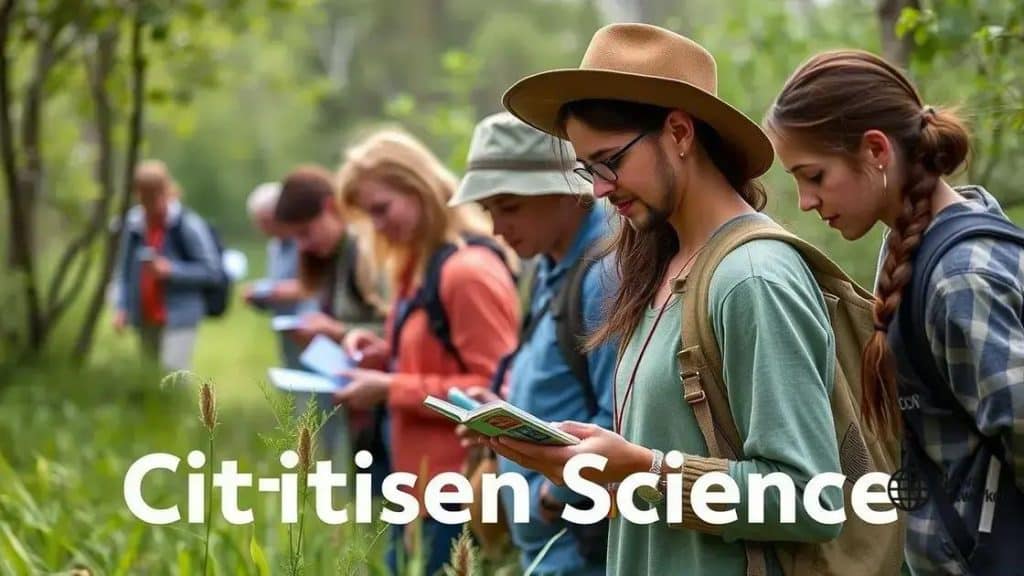The role of citizen science in environmental monitoring

The role of citizen science in environmental monitoring empowers individuals to contribute to vital research and data collection, enhancing community engagement while using innovative technologies.
The role of citizen science in environmental monitoring is gaining widespread recognition as communities come together to contribute valuable data. Have you ever wondered how everyday people can make a difference in environmental conservation? This movement empowers individuals to participate actively in monitoring and protecting their surroundings.
Understanding citizen science
Understanding citizen science is vital for grasping how ordinary people can contribute to important research and conservation efforts. This approach allows individuals to gather data, share observations, and engage in environmental monitoring.
Many communities rely on the support of citizen scientists to help track changes in local ecosystems. This involvement not only enriches the data collected but also strengthens community ties and education.
What is citizen science?
Citizen science involves members of the public participating in scientific research. This can include monitoring wildlife, collecting air or water samples, and documenting biodiversity. By engaging in these activities, citizens can play a crucial role in addressing environmental issues.
Benefits of engaging in citizen science
- Empowerment: Individuals gain confidence by seeing their contributions making a difference.
- Education: Participants learn more about their local environment and understand scientific processes.
- Data collection: Citizens provide valuable data that professionals may not be able to gather alone.
- Community building: Working together fosters collaboration and strengthens community bonds.
One impressive example of citizen science is the Audubon Society’s Christmas Bird Count. Volunteers across North America count birds and share their findings. This helps track bird populations and migration patterns effectively.
The data collected by citizen scientists can also influence conservation strategies. Local governments and organizations rely on this information to make informed decisions regarding land use and resource management. When communities unite for a common cause, they have a powerful impact on policy and change.
Participating in citizen science is also an opportunity for family bonding and education. Engaging children in these activities can spark curiosity and promote environmental stewardship. Whether it’s observing plants, animals, or weather patterns, every little contribution adds to a larger understanding of our planet.
Benefits of citizen science initiatives
The benefits of citizen science initiatives are numerous and impactful. These programs engage individuals in meaningful ways, allowing them to contribute to scientific research while fostering a sense of community and purpose.
By participating in citizen science, individuals can gain firsthand experience in data collection and analysis. This not only enhances their understanding of scientific methods but also allows them to contribute to critical research that can lead to significant environmental improvements.
Empowerment and connection
One major advantage is the sense of empowerment that comes from involvement. When individuals take part in a project, they feel more connected to their environment. This connection often translates into a greater passion for conservation and sustainable practices.
- Active engagement strengthens communities and fosters teamwork.
- Participants become advocates for environmental issues due to their firsthand experiences.
- People from various backgrounds learn from each other, enriching their perspectives.
- The initiative promotes social responsibility and awareness about local ecosystems.
Moreover, citizen science provides educational opportunities for participants of all ages. Schools and educational institutions can involve students in practical science activities that complement their curriculum. This hands-on approach ignites interest in scientific fields, especially for young learners.
In addition, citizen scientists can help gather data that professional researchers might overlook due to time or resource constraints. For example, local volunteers can monitor weather changes, track species migrations, or record pollution levels in their area. Their contributions enhance the overall database of knowledge about environmental conditions, which is crucial for future research.
The collaboration between scientists and community members leads to richer data collection, often resulting in higher quality research outcomes. When many people participate, the reach and accuracy of data can significantly increase, providing a fuller understanding of ecological issues.
Ultimately, citizen science initiatives create a pathway for individuals to engage with science actively. They encourage people to inform themselves about environmental challenges and participate in solutions, creating a more informed and proactive public.
Challenges faced by citizen scientists

Despite the numerous benefits, citizen scientists face several challenges that can hinder their contributions to research and environmental monitoring. Understanding these challenges is essential for improving citizen science initiatives.
One common issue is the lack of training and resources available to volunteers. Many citizen scientists may not have access to the necessary tools or knowledge to conduct effective research. This gap can lead to inconsistencies in data collection and analysis.
Time commitment and motivation
Another challenge is the time commitment required for participation. Many volunteers juggle jobs, family, and other responsibilities, which can limit their ability to engage consistently in citizen science projects. Maintaining motivation can also be difficult, especially when immediate results are not visible or measurable.
- Volunteers may feel overwhelmed by complex tasks, leading to frustration.
- Seasonal projects may not align with a volunteer’s availability, causing missed opportunities.
- Individuals may struggle to see the impact of their contributions, affecting their long-term commitment.
Furthermore, citizen science initiatives often rely on technology for data collection and communication. Not all volunteers may have access to smartphones or computers, which can create barriers to participation. Moreover, issues such as poor internet connectivity can hinder the ability to share findings effectively.
Another significant challenge is the potential for data quality concerns. Since volunteers come from different backgrounds and levels of experience, the validity of the data collected can vary. Ensuring that all participants understand the protocols and standards is crucial for maintaining the integrity of the research.
Lastly, citizen scientists may encounter difficulties in engaging with professional scientists. Sometimes, there can be a disconnect between research professionals and volunteers. Building a positive relationship and fostering communication can help bridge this gap, enabling more fruitful collaborations.
Successful examples of citizen science
Successful examples of citizen science demonstrate the powerful impact that engaged individuals can have on research and environmental conservation. These initiatives show how collaboration between scientists and volunteers leads to valuable data and meaningful change.
One prominent example is the Great Backyard Bird Count. This annual event invites people to count the species of birds they see in their backyards over a four-day period. The data collected helps researchers track bird populations and migration patterns across North America.
Project Noah
Another successful initiative is Project Noah, which encourages people to document wildlife in their area. Participants can upload their observations, which create a global map of species and habitats. This project fosters a sense of community among nature lovers while contributing to biodiversity research.
- Users can engage with others and share their findings.
- It helps raise awareness about local ecosystems.
- The initiative supports conservation efforts and education.
Moreover, the eBird program is an online platform that allows birdwatchers to report their sightings. By aggregating this data, researchers can analyze trends in bird populations and their habitats. This project has amassed millions of records from birdwatchers worldwide, showcasing the power of citizen engagement.
In addition to individual projects, universities and research institutions have initiated collaborative endeavors, such as the Cornell Lab of Ornithology, where citizens contribute to real scientific research. By training volunteers, they ensure that individuals can collect relevant and high-quality data.
These examples illustrate the potential of citizen science to not only gather data but also to foster a deeper connection between people and their environment. Through these successful programs, citizen scientists gain a sense of purpose and accomplishment, knowing their work contributes to greater scientific goals.
Future directions for environmental monitoring
The future directions for environmental monitoring involve leveraging new technologies and approaches to enhance the efficiency and effectiveness of data collection. Innovations such as remote sensing, artificial intelligence, and mobile applications are transforming how we gather and analyze environmental data.
One exciting development is the use of drone technology. Drones can access hard-to-reach areas, capturing high-resolution images and important environmental data. They provide a cost-effective way to monitor habitats and wildlife from above, giving researchers real-time insights into changes in the environment.
Integrating citizen science with technology
Another promising direction is integrating citizen science with technological tools. Mobile apps allow volunteers to report their observations easily. These applications can streamline data entry and ensure that data is consistent and usable. For example, platforms like iNaturalist let anyone document biodiversity and share findings with researchers seamlessly.
- This collaboration helps create extensive databases that are invaluable for research.
- It encourages community participation and awareness of local environmental issues.
- Available data can be used for various studies, enhancing scientific understanding.
The role of artificial intelligence in data analysis is also growing. AI can process large datasets quickly, identifying patterns that might be missed by human analysts. Machine learning algorithms can improve predictions about environmental changes, helping scientists make informed decisions faster.
Furthermore, integrating social media into environmental monitoring can amplify community outreach and engagement. Sharing real-time updates and findings can inspire others to participate and raise awareness about critical issues affecting their environment. Social media platforms can help form networks of citizen scientists united by common goals.
As technology continues to evolve, the importance of collaboration between researchers, citizen scientists, and communities is only going to increase. This collaborative approach can lead to more comprehensive environmental monitoring efforts that are both effective and inclusive.
In summary, the role of citizen science in environmental monitoring is transforming the way we understand and protect our ecosystems. By integrating innovative technologies like drones and mobile apps, and fostering collaboration between scientists and communities, we can create more effective and inclusive monitoring programs. As more people get involved, we can not only collect valuable data but also inspire a deeper connection to the environment. Together, we can make a significant impact on our planet’s future.
FAQ – Frequently Asked Questions about Citizen Science in Environmental Monitoring
What is citizen science?
Citizen science is the involvement of the public in scientific research and data collection, helping to monitor environmental changes.
How can I participate in citizen science projects?
You can join local initiatives or online platforms that offer opportunities to collect data on wildlife, water quality, or other environmental factors.
What are the benefits of participating in citizen science?
Participants gain hands-on experience in science, contribute to important research, and help raise awareness about environmental issues.
Are there any challenges associated with citizen science?
Yes, challenges include the need for training, time commitment, and ensuring data quality.





